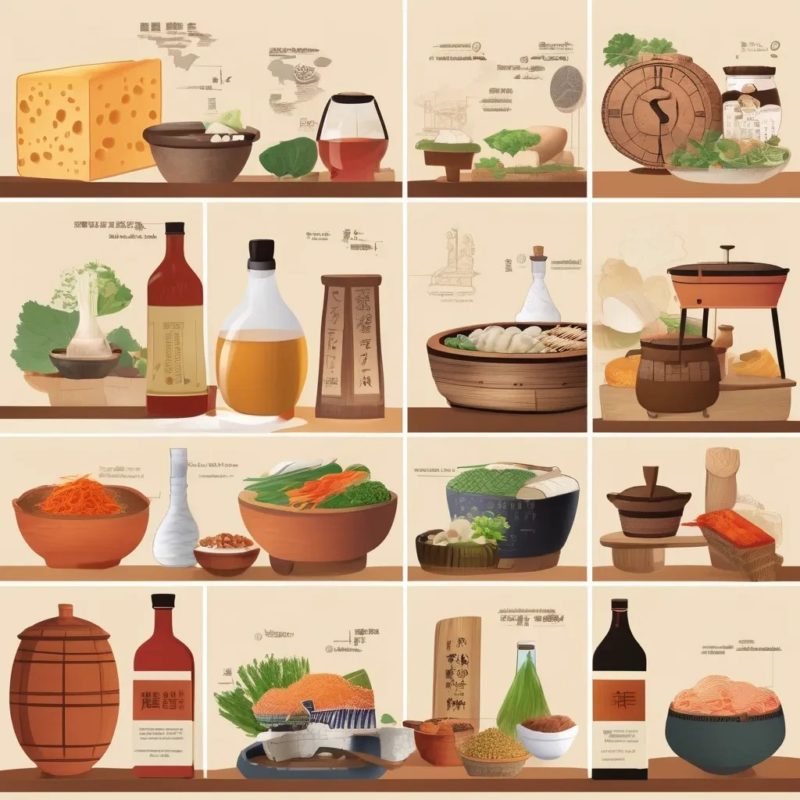Fermentation, a process deeply rooted in human history, has been essential to food preservation, flavor enhancement, and nutrition for thousands of years. This article delves into the History of Fermentation, its origins, development, and cultural significance, tracing its journey from ancient civilizations to modern science. Along the way, we’ll explore how fermentation has shaped dietary practices, supported health, and even influenced the development of early societies.
Early Beginnings of Fermentation
The origins of fermentation are difficult to pinpoint, as the process likely began accidentally when food or drink was left to sit and naturally fermented due to environmental conditions. The earliest evidence of deliberate fermentation dates back to around 7000 BCE in China, where pottery jars containing residues of fermented beverages made from rice, honey, and fruit were discovered. These early fermented drinks were not just consumed for their intoxicating effects but also for their medicinal properties, as the fermentation process was thought to purify the drink.
In ancient Mesopotamia, the Sumerians were brewing beer as early as 4000 BCE. Beer, referred to as “liquid bread,” became a staple in their diet, providing a safe source of hydration and nutrients in a time when clean water was not always available. The brewing process involved the fermentation of barley, which was one of the earliest domesticated grains. The Sumerians even had a goddess of beer, Ninkasi, who was celebrated with hymns that included brewing instructions, indicating the importance of beer in their culture.

Similarly, in ancient Egypt, fermentation played a crucial role in daily life. The Egyptians are credited with the widespread use of sourdough for baking bread, a practice that likely began around 3000 BCE. Sourdough fermentation not only improved the flavor and texture of bread but also extended its shelf life, which was essential in the hot, arid climate of Egypt. Additionally, Egyptians produced beer, which was considered a gift from the gods and was consumed by all social classes, including children.
The Spread of Fermentation Practices
As civilizations expanded and interacted, fermentation techniques spread across the globe. The process was adopted and adapted by various cultures, each contributing to the rich diversity of fermented foods we see today.
In Asia, fermentation became central to the diet, with foods like soy sauce, miso, and fermented vegetables such as kimchi and pickles becoming dietary staples. In Korea, kimchi, a fermented vegetable dish typically made from napa cabbage and radishes, dates back to at least the 7th century. Kimchi was traditionally stored in large earthenware jars buried underground to ferment during the cold winter months, preserving the vegetables and providing essential vitamins and nutrients during times when fresh produce was scarce.
In Japan, fermentation has been an integral part of food culture for centuries. Miso, a fermented soybean paste, has been consumed in Japan for over 1,300 years. It is made by fermenting soybeans with salt and a mold called Aspergillus oryzae, creating a savory paste that is rich in umami flavor. Miso is a key ingredient in many Japanese dishes, including the well-known miso soup, and it is valued for its nutritional benefits, including being a good source of protein and probiotics.
Fermentation also played a significant role in the development of dairy products in Europe. Yogurt and cheese, both products of milk fermentation, have been produced for thousands of years. The earliest evidence of cheese-making dates back to around 5500 BCE in what is now Poland, where researchers found traces of fatty acids consistent with cheese in ancient pottery. The process of fermenting milk into yogurt and cheese not only extended the shelf life of milk but also made it more digestible for people who were lactose intolerant.
In the Mediterranean region, fermentation was central to the production of wine and olive products. The ancient Greeks and Romans perfected the art of winemaking, and wine became a crucial part of their culture, used in religious rituals, social gatherings, and daily meals. Olive fermentation, particularly in the production of table olives, also dates back to these times, with the process enhancing the flavor and preserving the fruit for extended periods.
Fermentation in Traditional Medicine
Fermented foods were not only valued for their taste and preservation qualities but also for their medicinal properties. Traditional Chinese medicine, Ayurveda in India, and various indigenous practices around the world have long recognized the health benefits of fermented foods. These foods were believed to balance the body’s natural processes, improve digestion, and boost the immune system.
In Europe, before the advent of modern medicine, fermented foods like sauerkraut and yogurt were used to prevent and treat a variety of ailments. Sailors consumed sauerkraut on long voyages to prevent scurvy, a disease caused by vitamin C deficiency. The fermentation process increases the availability of vitamins in food, making sauerkraut an excellent source of vitamin C.
Yogurt was another fermented food widely used for its health benefits. In the early 20th century, Russian biologist Elie Metchnikoff popularized the consumption of yogurt after observing the longevity of Bulgarian peasants who regularly consumed fermented milk products. Metchnikoff’s research suggested that the lactic acid bacteria in yogurt contributed to a healthy gut microbiome and could help delay aging.

The Science of Fermentation
The scientific understanding of fermentation began to develop in the 19th century, primarily through the work of Louis Pasteur, a French microbiologist and chemist. Pasteur’s research on the fermentation of sugar into alcohol by yeast led to the discovery that microorganisms were responsible for fermentation. This discovery was groundbreaking, as it not only explained the process of fermentation but also paved the way for the development of microbiology as a scientific discipline.
Pasteur’s work also had practical applications in the food and beverage industry. He developed the process of pasteurization, which involves heating liquids to kill harmful bacteria while preserving the desired fermentation properties. Pasteurization revolutionized the production of beer, wine, and dairy products, making them safer to consume and extending their shelf life.
Further advancements in the 20th century led to a deeper understanding of the role of bacteria in fermentation. Researchers identified specific strains of bacteria and yeast responsible for different types of fermentation, leading to the development of commercial starter cultures for consistent and controlled fermentation processes. This scientific approach to fermentation has allowed for the mass production of fermented foods and beverages, making them more accessible to people around the world.
Modern Fermentation and Its Revival
In recent years, there has been a resurgence of interest in fermentation, driven by a growing awareness of the health benefits of fermented foods and a desire for natural and sustainable food practices. This revival is part of a broader movement towards traditional and artisanal food production, where consumers seek out high-quality, minimally processed foods.
Fermented foods are now recognized for their role in supporting gut health, as they contain probiotics—live bacteria that are beneficial for the digestive system. Probiotics help maintain a healthy balance of gut flora, which is essential for digestion, immune function, and even mental health. Studies have shown that a healthy gut microbiome can reduce the risk of chronic diseases, improve mood, and enhance overall well-being.
The modern food industry has embraced fermentation, with a wide range of fermented products now available, from kombucha and kefir to artisanal cheeses and cured meats. These products cater to the growing demand for foods that are both delicious and health-promoting. Additionally, fermentation has become a popular practice among home cooks and DIY enthusiasts, with many people fermenting their own vegetables, sourdough bread, and beverages at home.
The environmental benefits of fermentation are also gaining attention. Fermentation is a natural and energy-efficient method of food preservation that reduces the need for refrigeration and other forms of energy-intensive processing. Fermented foods also contribute to reducing food waste, as fermentation can extend the shelf life of perishable ingredients and turn surplus produce into valuable food products.
Conclusion
The history of fermentation is a testament to human ingenuity and the enduring importance of this ancient practice. From its accidental discovery to its role in shaping civilizations and advancing scientific knowledge, fermentation has been a cornerstone of human development. Today, as we continue to explore the health benefits and sustainable practices associated with fermentation, this ancient process remains as relevant as ever.
Whether you’re enjoying a glass of wine, a bowl of yogurt, or a jar of homemade kimchi, you’re participating in a tradition that has been passed down through the ages. As we look to the future, the continued exploration and innovation in fermentation will no doubt lead to new and exciting developments in food, health, and sustainability.
This site is a participant in the Amazon Services LLC Associates Program and contains affiliate links to products. We may receive a commission for purchases made through these links.

[…] The History of Fermentation […]